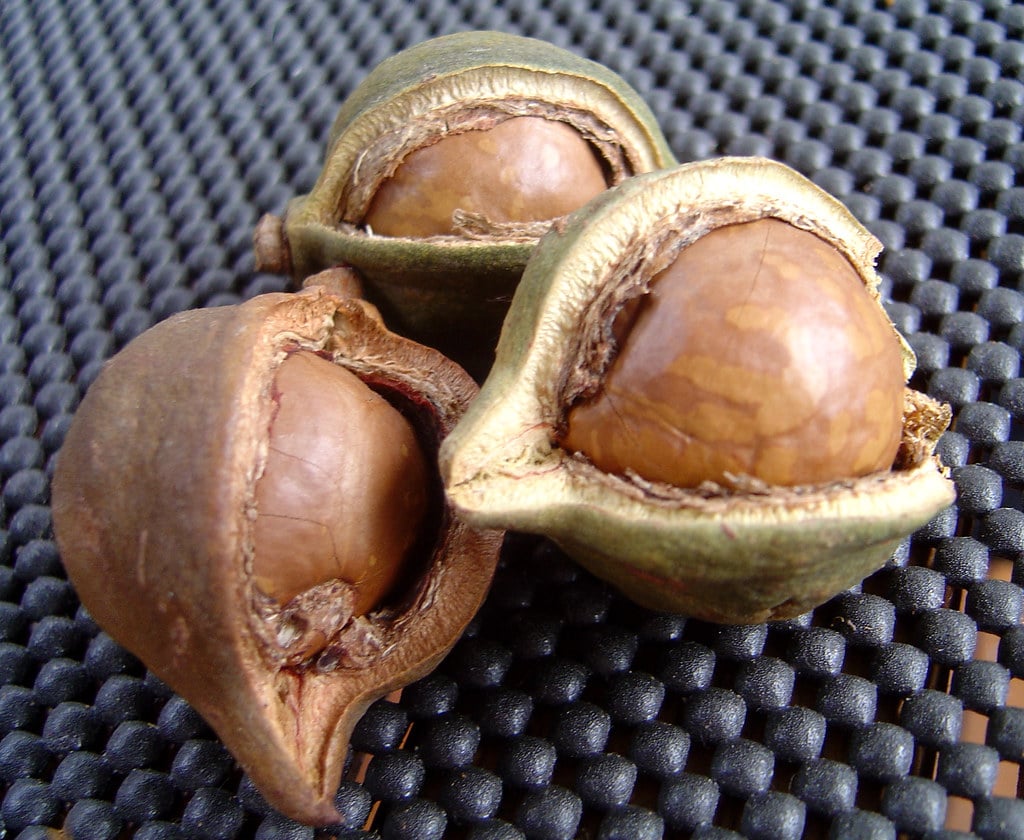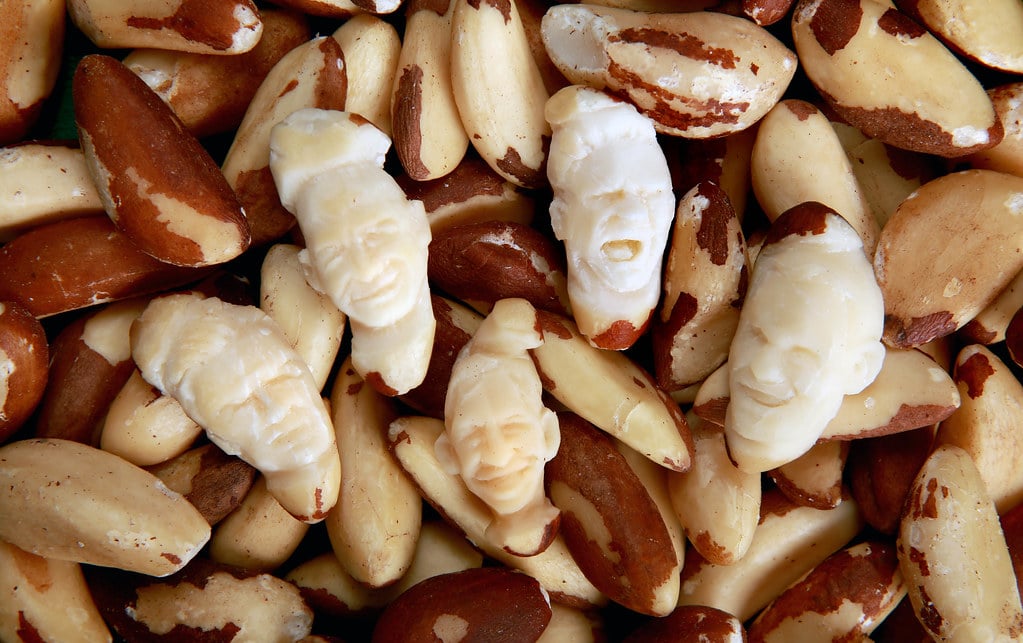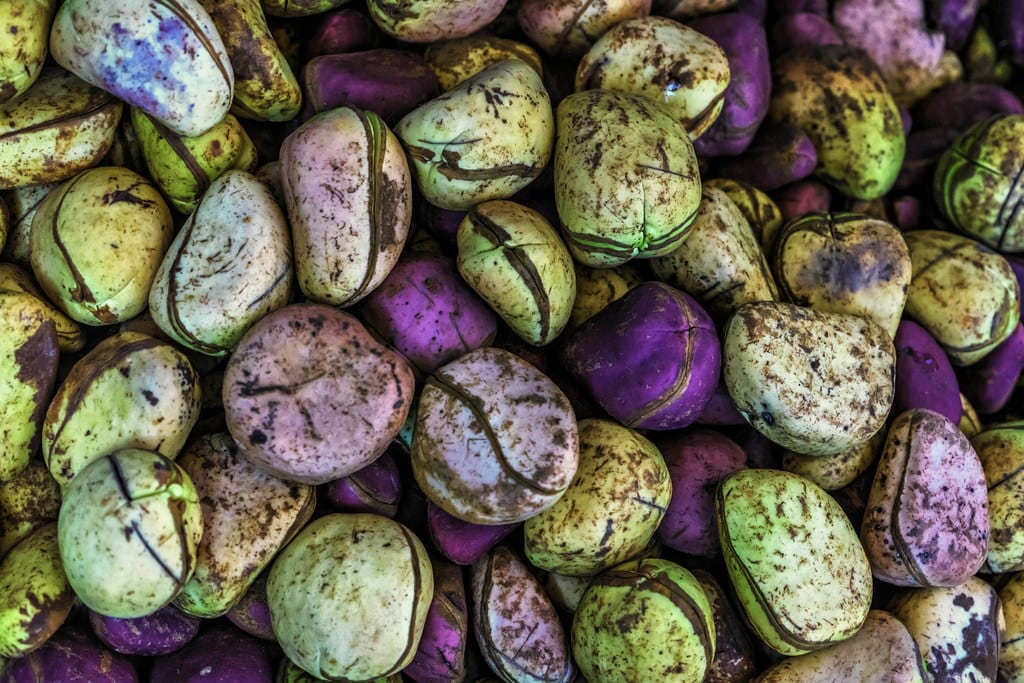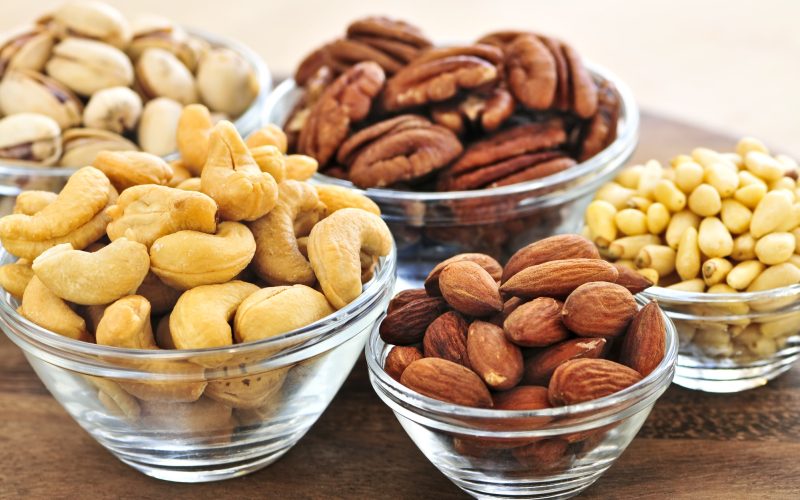Thanks to the variety of vitamins and minerals found in different types of edible nuts, nuts can be consumed as a snack or as part of a normal meal and offer several advantages.
Antioxidants included in nuts aid in lowering free radicals, which are responsible for inflammation in our bodies.
Edible nuts come in a wide variety and are available everywhere. Some of these edible nuts are often used as ingredients in cooking or are processed into numerous commercial goods.
The top types of edible nuts you can add to your diet are listed in our article below
1. Almond

Almonds are coming first on our list of types of edible nuts. In the US, almonds are the most widely consumed nut.
The almond trees that produce these tree nuts are indigenous to the Mediterranean regions. A seed is an almond.
Almonds have a hard shell that is removed in order to get at the tasty interior.
Almonds, regarded as nutritious food, include biotin, fiber, protein, healthy fats, and several vitamins and minerals.
These edible nuts also make various industrial goods, including almond milk, flour, and oil.
2. Hazelnuts

Filberts and cobnuts are other names for hazelnuts. They originate from hazel trees found naturally in western Asia and Europe.
These nuts can be identified by their small, rounded shape and thick, dark-brown skin on the kernels.
You have consumed hazelnuts if you’ve ever gotten Nutella or Gianduja on your bread or cookies.
These types of edible nuts are exploited for commercial purposes to create those delicious chocolate spreads.
Hazelnuts are frequently used to make baking flour, Belgian praline, and other flavorings for snacks and desserts.
Additionally, they include a lot of protein, anti-oxidants, monounsaturated fats, and other important vitamins and minerals.
3. Cashews Nuts

Cashews are also on our list of types of edible nuts. Tropical evergreen trees with Brazilian origins produce cashew nuts.
Cashew trees are grown commercially in several nations today, including India, Indonesia, Nigeria, Ivory Coast, the Philippines, and Vietnam.
Cashews are biologically classified as seeds while being generally known as nuts.
Cashews are easily distinguished thanks to their kidney-shaped form.
You can make cashew milk out of cashews or eat cashews as a convenient snack.
Cashews can produce cashew chicken and stir-fries in various Chinese recipes.
Additionally, cashew nuts are a great source of protein, fiber, good fats, magnesium, vitamins K and B6, iron, and other essential minerals.
4. Peanuts

Peanuts, often called groundnuts, earth nuts, or monkey nuts, are the seeds of a South American-native plant member of the Fabaceae botanical family.
Other legumes, including soy, lentils, and beans, are relatives of peanuts.
Because of their high protein content, these edible nuts are used to manufacture baked goods, peanut butter, and peanut oil.
Additionally, some folks will roast peanuts and consume them as snacks.
Despite not being considered real nuts, peanuts have the same nutritional value as almonds and walnuts.
They are also a good source of biotin, which aids in transforming food into energy in our bodies.
5. Macadamia Nuts

Macadamia trees that produce macadamia nuts are descended from a single Australian native tree.
The top producer of macadamia nuts now is Hawaii, followed by South Africa.
These edible nuts are identified by their buttery flavor and large, light-brown shells.
Harvesters typically gather these nuts from the ground to prevent mildew before storing them in temperature-controlled areas.
They are used in various commodities and baked goods, including granola, chocolate, muffins, pies, cookies, and chocolate. In some cuisines, macadamia nuts are even used.
6. Mongongo Nuts
Mongongo nuts, sometimes referred to as manketti nuts or mongongo nuts, are produced by manketti trees, indigenous to the Kalahari Desert in southern Africa.
They can be identified by their light brown kernels and thick brown shells.
Protein, calcium, and vitamin E are just a few of the nutrients that mongongo nuts are high in. You can eat them roasted, raw, or even steamed.
These nuts are used to make manketti oil, which aids in moisturizing and conditioning hair and nails, in addition to their nutritional value.
7. Brazil Nuts

Bertholletia excelsa trees, which are mostly found in Brazil, Peru, and Bolivia, are native to the Amazon rainforest and are used to produce Brazil nuts.
Each pod the tree produces contains several Brazil nuts, and they are all covBrazil nuts can be eaten raw or blanched and have a nutty, buttery flavor.
They can make various dishes like milk, macaroons, and cookies. Brazil nuts are also added to salads as a garnish.
8. Pine Nuts

The seeds of several kinds of pine trees, particularly those native to Europe, China, Italy, and the United States, are known as pine nuts.
Pine nuts are distinguishable by their small size, ivory color, oily texture, and half-inch length.
The flavor of pine nuts is sweet and buttery. After being dried and toasted, they are typically eaten.
Pesto is made using these nuts, which are added to other recipes.
Additionally, they can be used to make cookies and cakes by blending them with baking ingredients and dough.
9. Kola Nuts

Kola nuts are also on our list of edible nuts with a brownish-red exterior and roughly the size of a walnut.
Caffeine can be found in the nut’s white inside. Cola acuminata and Cola nitida are the two primary species.
Cola acuminata is primarily found in West Africa, whereas Cola nitida is the more widespread species.
It has a high concentration of theobromine and other bitter alkaloids and 2% to 3% caffeine. Its quinine component is what gives it its bitter flavor.
It has a quinine content that ranges from 1.0% to 2.5% on average. The cotyledons (nutshells) contain about 60% of the alkaloid content.
The tropical African rainforests are the kola nut’s natural habitat.
It is grown throughout the continent, particularly in Nigeria, Ghana, the Ivory Coast, Senegal, Cameroon, and the Democratic Republic of the Congo.
It can be chewed either fresh or dried and powdered. It is frequently used in foods and beverages as a flavoring agent.
10. Hickory Nuts

They originate from hickory trees and have hard shells. Hickory trees come in various species, each producing a distinct variety.
The shagbark hickory is the most prevalent of these trees indigenous to the eastern United States.
The edible kernel of a hickory nut, which can be anywhere between an inch and two inches in diameter, has a sweet, rich flavor.
Shagbark: The most popular type is hickory. The tree’s shaggy bark is where they receive their name. Sweet and fatty beef is inside.
Pignut: Compared to shagbark hickory, hickory nuts are smaller and more oblong. Shagbark is delicious, but the meat within is bitter.
Bitternut: The tiniest nuts are hickory ones. The flesh inside is extremely bitter, and they have a smooth exterior.
Although not frequently consumed raw, these can be roasted or turned into flour.
11. Paradise Nuts
Paradise nuts are also one of the types of edible nuts. The seeds of a tree in the Caryocaraceae family that are endemic to Central and South America are called paradise nuts (sometimes referred to as baru nuts).
The tree is tall and lean, with white blossoms and dark green foliage. The fruits are drupes resembling cherries with a big, tough seed inside.
Caryocar Brasiliense, which may be found in Bolivia, Brazil, and Peru, is the most widespread species of paradise nut.
Caryocar guatemalense (Guatemala), Caryocar costaricense (Costa Rica), and Caryocar Nicaraguan Rum (Nicaragua) are some further species.
Before consumption, they are normally roasted, and they can also be made into flour for use in various recipes, such as cakes, cookies, and bread.
They can be kept in a cold, dry environment for up to six months. If you store them in an airtight container, they will remain fresh longer.
12. Walnuts

This is the last on our list of types of edible nuts. The walnut is a drupe with a hard shell encircling an exterior fleshy layer.
The most prevalent species is the black walnut, which is endemic to North America. English, Californian, and Japanese walnuts are a few further common kinds.
Walnuts should be kept in a dry, cool environment. They can be frozen for up to six months but may grow mold or mildew if kept in a moist environment.
13. Pecans

North American native tree nuts include pecans. There are various varieties of pecan trees, but the Illinois pecan tree, or Carya illinoinensis, is the most widespread.
Warm conditions are ideal for pecan growth, necessitating much water.
The trees can live for over a century and reach heights of up to 100 feet. Pecans often have an oblong or oval shape with a smooth, brown shell.
The exocarp, a thin, papery layer that covers the nuts, protects them.
The endocarp, a tough outer shell, is located inside the exocarp. The pecan’s kernel, which is located inside the endocarp, is the only component that may be eaten.
You can consume these types of edible nuts raw or roasted. They are widely used in pies, cakes, and cookies, among other sweets.
Additionally, savory recipes like stuffing and salads incorporate pecans.
14. Pili Nuts

In the Philippines and other Southeast Asian nations, the pili nut is a staple meal.
Its oil is used for cooking and as a dietary supplement and is a source of vitamins and minerals.
Traditional medicine uses these types of edible nuts to cure various illnesses.
The trees can reach a height of 30 meters and bear huge clusters of yellow-orange fruits, each containing a sizable seed.
Depending on the type of tree they come from, they have a variety of sizes and shapes.
The Philippine pili nut is the most popular variety; it has an oval shape and dark brown or blackish skin.
Pili nuts can be grown in plantations but are mainly taken from the wild.
Pili nut trees are planted in the Philippines’ Albay, Camarines Sur, Sorsogon, and Masbate provinces.
You can’t believe these edible nuts are frequently used to flavor soups and other foods.
Pili nuts are used to create pili nut oil, consumed as a dietary supplement and for cooking.
15. Pistachio

Pistachios are tiny, sweet-tasting types of edible nuts that have been cherished for a long time.
They are members of the Anacardiaceae family, which also includes cashews and mangoes.
They are well-liked in many international cuisines because of their distinctive nutty flavor.
These tasty tiny edible nuts are wholesome, making them the perfect snack for people trying to live a healthy lifestyle.
The two primary species of pistachios are the American pistachio (Pistacia vera) and the Chinese pistachio (Pistacia chinensis).
The Chinese species is typically grown as a decorative tree, whereas the American version is most frequently consumed raw or in desserts and candies.
The Chinese variety is grown in southwest China and northeastern India, and both varieties are indigenous to the Middle East.
When pistachios reach maturity in the autumn, they are picked.
Due to its drought tolerance, pistachio trees may thrive in arid environments with little or no water.
They can resist temperatures of up to 40 degrees Celsius and are heat-tolerant.
16. Soy Nuts
East Asia is the original home of the legume species known as soy nuts. They are produced from dried soybeans that have been roasted or boiled.
Soy nuts can be consumed as a snack or used for meals and are a rich source of protein, fiber, and vitamins.
Although there are several varieties of soybeans, the black soybean is the one that is most frequently used to make soy nuts.
Although soybeans are grown in many different nations, China produces the bulk of the world’s soybeans.
17. Tiger Nuts

Numerous creatures, including elephants, rhinoceroses, warthogs, and primates, rely on tiger nuts, which are underground tubers that grow.
The African and Asian tiger nuts are the two primary species.
The more well-known of the two is the African type, which is grown over most of Africa, including Sudan, Nigeria, and Senegal.
China, India, and other nations in Asia all grow the Asian variety.
You can eat them raw, roast them, or make flour out of them. In baking recipes that are Paleo and gluten-free, tiger nut flour is a common component.
Tiger nuts should be kept in a dry, cool environment. They can be kept in the refrigerator for up to two weeks if they are not consumed within a few days.








